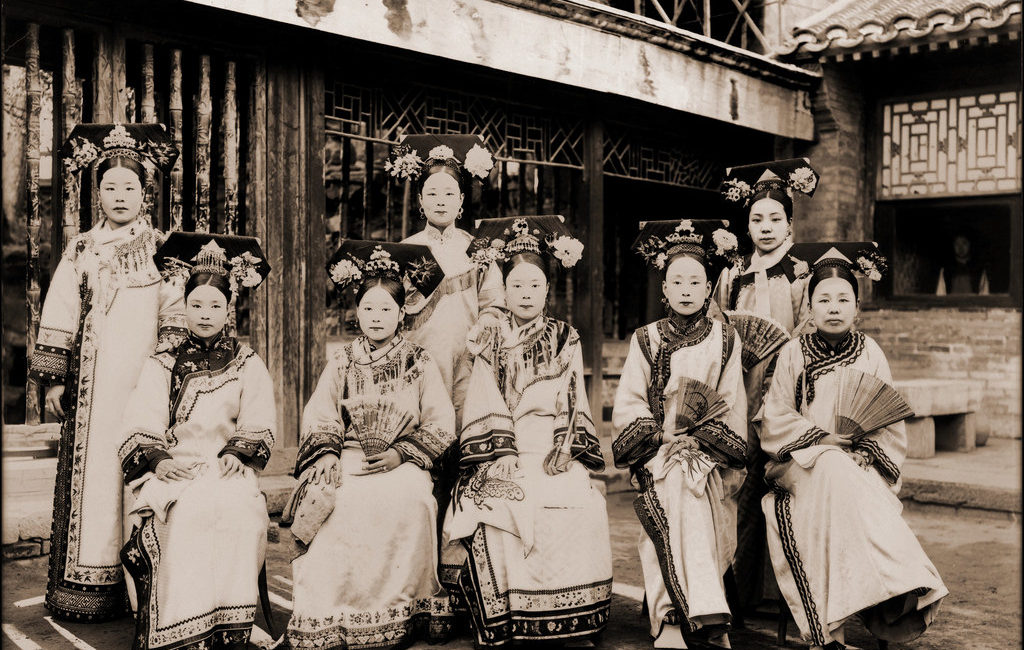Cardboard Cutouts: The Paradox of Female Power

Image Credit: Library of Congress (Flickr)
Josie Gidman
Read the Faculty Introduction
“Now, Enkidu, you know what it is to be with a woman, to unite with her. You are beautiful, you are like a god. Why should you roam the wilderness and live like an animal?”
– Shamhat to Enkidu
In The Epic of Gilgamesh, these are the first words from Shamhat, the temple priestess, to Enkidu, the strong and savage man created by the gods to balance the hero Gilgamesh’s power, after they engage in intercourse. Despite fitting naturally within the context of the epic, her pronouncements are unexpectedly significant. Shamhat’s words, together with the overall image of her seduction of Enkidu, intimate particular powers of women that further the central themes of the epic, including the question of what it means to be human and the desire of humans to be god-like. As a result, the scene of Shamhat’s seduction initially appears to be a portrayal of the efficacious powers of females – specifically females’ capacity for philotes and the mysterious faculties of the femme fatale. These capabilities are empowering for women, who are often represented as weak or in need of help. However, a closer analysis of Shamhat’s words to Enkidu following her seduction reveals a crucial paradox that challenges this initial interpretation: although female powers effectively convey the epic’s critical themes, we can see that the female characters who exhibit these powers are reduced to their sexual function. By exposing how the text conflates female powers with females themselves, I seek to reveal the cardboard quality of the epic’s portrayal of female characters. In the same way that cardboard appears to be three-dimensional, but its flimsiness and emptiness attest to its true, two-dimensional nature, the female powers in the story only give the illusion that the women in the epic are characters in their own right. Rather, just as easily as cardboard is flattened by even the tiniest of weights, a closer look into the female powers presented in the epic reveals the empty, two-dimensional nature of the women in Gilgamesh.
Shamhat’s exemplification of the uniquely female capacity for philotes initially appears as a presentation of female power in the epic on account of its critical role in portraying the theme of “human-ness.” The feminist philosopher Luce Irigaray defines philotes as a female form of “tenderness and affection” that gives the act of sex its “human dimension”: it is a love that “is both carnal and spiritual” (Irigaray 94). In the epic, Shamhat expresses philotes in her relationship with Enkidu through the utilization of her “love arts”: her affectionate kisses and passionate sexual acts, concerned and complimentary conversation following intercourse, and her continued care for him as she leads him to Uruk (Mitchell 80). Through her demonstration of this inherently “human love,” Shamhat communicates the central theme of “human-ness” and alerts the reader to be attentive to other instances in the epic that shed light on what it means to be human (Irigaray 94). Such instances include the variety of strong (innately human) emotions that friends Gilgamesh and Enkidu exhibit as they journey to kill Humbaba, the monster, the two heroes’ desire to find deeper meaning in human experiences as they interpret Enkidu’s dreams, and Gilgamesh’s uneasiness with the reality of human mortality. These later depictions of “human-ness” are more apparent and compelling than they might be otherwise because Shamhat’s seduction, through which she was able to express the uniquely female “power” for philotes, effectively awakens the reader to the theme early on in the tale.
However, Shamhat is not a character who communicates the theme of “human-ness” in the epic: she is a vessel through which to achieve “human-ness.” Through her acts of philotes, Shamhat elevates Enkidu from beastlike ignorance to human awareness. Included in the epic is the detail that, following intercourse, Enkidu “knew that his mind [had] somehow grown larger” (Mitchell 79). The enlightenment of Enkidu reduces the female power of philotes to a merely transformative power, and moreover conflates Shamhat with that power – Shamhat herself becomes the means, the vessel, or the instrument through which to achieve enlightenment. Shamhat’s demonstration of philotes thus reveals a central paradox in the epic regarding female power: although Shamhat’s distinctly female capacity for philotes is crucial to the conveyance of the central theme of “human-ness” in the epic, her elevation of Enkidu results in the unwarranted conflation of her with her power. The reduction of Shamhat from a woman capable of expressing philotes to a mere vessel that embodies the transformative potential of philotes exposes the overall cardboard quality of this female power as presented in the epic.
Generally recognized as a stock character in film noir cinema of the 1940s, the femme fatale, or “deadly woman,” uses her charm and sexuality to seduce men (frequently bringing about disaster for the men). The modern archetype draws on a legacy of mythical seductresses and temptresses whose sexuality results in destruction, from the Greek witches Circe and Medea to the biblical Eve. The femme fatale’s sexual powers are so great that they might be said to be supernatural. The epic’s portrayal of Shamhat as a femme fatale also initially appears as a genuine portrayal of female power, especially because of the crucial role the analogy plays in conveying another major theme of the epic: the human desire for equivalency with the gods. The flattering, charming nature of Shamhat’s comments following the seduction – calling Enkidu “beautiful” and god-like – and the very fact that she set a “trap” to seduce him by waiting on the ground naked, is reminiscent of the female power exemplified by femmes fatales (Mitchell 80). This association is even stronger in light of the fact that she is a temple priestess, and thus has a femme fatale-like connection to the supernatural. Moreover, Shamhat’s comparison of Enkidu to a god following the act of intercourse – when only days ago he was living as an animal – betrays her eagerness for humans to be equivalent with the gods and consequently establishes an important connection between Shamhat and another famous female of the Western tradition who desired to be godlike: Eve of the Genesis creation story. Eve, the first woman, has been interpreted by many to be the original archetype of the femme fatale. By eating the forbidden fruit out of a desire to “be like God himself” (The Oxford Study Bible, Gen. 3.5), she disobeyed God and doomed all of mankind. The association in The Epic of Gilgamesh of females with femmes fatales through the portrayal of Shamhat as a seductress (evidenced through her words and behavior during and after intercourse with Enkidu) serves as the first and most straightforward communication of the crucial theme in the epic of the human desire for immortality or god-like status. Consequently, such an association deepens the reader’s understanding and appreciation of later parts of the epic regarding that theme – such as Gilgamesh’s journey to gain immortality.
However, Shamhat is not depicted simply as a woman who utilizes the particular female powers often attributed to femmes fatales; rather, the epic’s portrayal of her ploy to seduce Enkidu and her use of flattering language suggests that she is, in some sense, a femme fatale. The epic’s association, though indirect, of Shamhat with the concept of a femme fatale serves to label, stereotype, and ultimately de-individualize her – and women in the epic in general. In regards to the female power of seduction of men, Shamhat has already internalized the de-individualizing label of the femme fatale when she deemphasizes the importance of her role as an individual in regard to intercourse with Enkidu; she states that her seduction showed him what it is like to be with “a woman” in general, rather than with her particularly (Mitchell 80). The effect of this pronouncement is that women are regarded as femmes fatales first and foremost at the expense of being appreciated as multifaceted beings who occasionally garner sexual influence. The use of this stereotype exposes the underlying paradox of female power in the epic: although the female power attributed to femmes fatales is strong enough to demonstrate the epic’s theme of the longing of humans for equivalency with the gods, the fact that Shamhat is portrayed as a femme fatale in the first place reduces this female power to a clichéd stereotype. It is precisely this reduction that points to the cardboard quality of the female powers on display in the epic.
The latent paradox surrounding the portrayal of female powers in the epic serves an important patriarchal purpose: it diminishes the influence of female powers and claims them for male use. That is, not only does the power of philotes become a transformative means for male ends, but also the expression of the power of seduction guarantees the labeling, stereotyping, and de-individualizing of women as femmes fatales. The brilliance of the paradox lies in the fact that some readers, who would normally be troubled by an inequitable portrayal of females, might be appeased by the obvious importance and seeming three-dimensionality of their powers of philotes in relation to the conveyance of the central themes of the epic. However, by carefully noting the disjunction between the portrayal of women as complex characters and the portrayal of women with the power of philotes, astute readers can avoid the interpretive pitfall of heralding Shamhat. Her appearance of depth comes at the expense of a more critical consideration – that seemingly empowering images of women can circulate to achieve patriarchal ends.
Works Cited
Irigaray, Luce. Thinking the Difference: For a Peaceful Revolution. Translated by Karen Montin. London: Athlone, 1994.
Mitchell, Stephen, translator. Gilgamesh: A New English Version. Free Press, 2004.
The Oxford Study Bible: Revised English Bible with the Apocrypha. Edited by M. Jack Suggs, Katharine Doob Sakenfeld, and James R. Mueller. Oxford UP, 1992.




Recent Comments